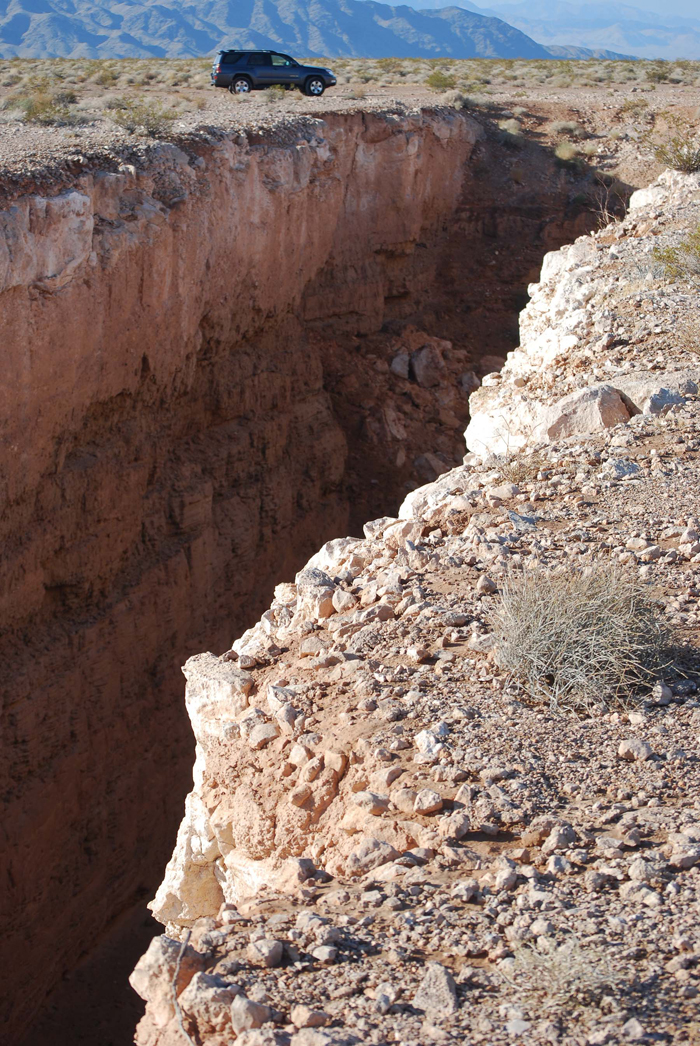
Michael Heizer, Double Negative, 1969–70. 240,000-ton displacement of rhyolite and sandstone; 50 x 30 x 1,500 ft. The Museum of Contemporary Art, Los Angeles, gift of Virginia Dwan. Photo: Glenn Harcourt, 2012.
Ends of the Earth: Land Art to 1974 at the Museum of Contemporary Art’s Geffen Contemporary, in Los Angeles, is an ambitious and challenging show. Its approach is avowedly revisionist and its reach is resolutely global. The curators, Philipp Kaiser and Miwon Kwon, have assembled an enormous body of material: both actual and virtual works as well as documentation in a wide range of forms and formats.1 They have also organized a linked series of catalog essays by contributing scholars2 and oral histories from key gallerists and museum professionals3 as a way of articulating in detail the re-reading outlined in their introduction. The upshot is a major contribution to our understanding of individual works and particular artists, as well as of the unfolding course of a complex artistic history deftly contextualized and securely rooted in the expansive landscape of cultural production.
Within this enormously expanded interpretive field with its heterogeneous collection of objects, artifacts, actions, interventions, and conceptualizations, there is room both to reconsider the displacement of 240,000 tons of rhyolite and sandstone from the edge of a Nevada mesa that constituted the massive inscription of Michael Heizer’s iconic 1969–70 masterpiece Double Negative, and to suggest a preliminary approach to his recently completed work at LACMA, Levitated Mass. Heizer in fact declined to participate in the MOCA show and none of his work appears in the exhibition; but his presence at the beginning of the American art/desert narrative, as well as at other key moments and locations, is felt as pervasive throughout.
A powerful reason for the pervasiveness of that presence is surely rooted in the way in which his work engages one of the oldest and most intractable of the oppositions that serve to articulate our sense of our own humanity: that between “Nature” and “Culture.” Indeed, it is an easy, almost “natural,” intellectual strategy to assert that the originating fact of our humanity—what we might call the moment of “culture”— comprises the realization of our alienation from that all-encompassing Other that will in its turn become the world of Nature, although exactly what constitutes the fact of that realization has been relentlessly contested.4 Although the relationship is in fact fraught with difficulties and complexities, historians of culture who have seen their own practice as rooted in the Renaissance tradition of the humanities or studia humaniora (to use the proper Erasmian designation) have been largely content to rely on a rather simplified opposition, as formulated here by the great humanist art historian Erwin Panofsky: “It [is] reasonable, and even inevitable, to distinguish, within the realm of creation, between the sphere of nature and the sphere of culture, and to define the former with respect to the latter, i.e., nature as the whole world accessible to the senses, except for the records left by man.”5
And it is just this kind of opposition that is invoked by John Beardsley’s catalog for the 1978 Hirshhorn Museum show Probing the Earth: Contemporary Land Projects,6 identified by the Hirshhorn’s then-director Abram Lerner as the first attempt to make “land projects…the exclusive focus of a major museum exhibition.”7 Beardsley defines the focus of that exhibition as “a group of works which are intended to establish an ongoing relationship with a particular site…[and which] all share in being a tangible and continuing presence in the landscape itself.”8 Although their actual presence in a particular location necessarily makes their relationship to that site a “reciprocal” one (they are altered by the conditions of exposure in the world even as they alter the character of the site by their presence), such works are in a sense mere literalizations of the kind of thematic expressed already in the sixteenth century, for example, by Giorgione’s magnificent Dresden Venus (c. 1508/10).9
It is quite another kind of reciprocity, however, that underlies the structural logic informing Ends of the Earth: a reciprocity not simply between work and site (although that relationship is tacitly assumed and explicitly invoked as necessary in the discussion of particular works) but a reciprocity between Nature and Culture tout court, which are seen as mutually defining systems, both opposing and reinforcing one another. Nature, “the elusive, originary Other” is reconstituted as “a system we are fundamentally native to, but unavoidably separate from; one that produces us, even as we (physically, conceptually, discursively) produce it; a complex of spaces, structures and organisms inexhaustibly good to think (and work) with.”10 As a visual metaphor for this reconstituted system with its interpenetrating reciprocities, one could hardly do better than Hreinn Fridfinnsson’s House Project of 1974, in which (literalizing a conceit first suggested in a novel by his fellow Icelander Thorbergur Thordarson) the artist constructed an “inside-out” house on a barren and hostile lava field outside of Reykjavik.11 The house reverses the constructed signifiers of “interior” and “exterior,” to the end that the inside of the house now no longer encloses the cultural space of habitation but opens that space out onto a vast expanse of black and forbidding lava—a natural and uninhabitable wasteland.
Indeed, like Fridfinnsson’s house, the exhibition as a whole draws our attention again and again to the land itself, which (inter alia) functions as ground, support, material, frame, absence, presence, and a thing to be consecrated, violated, inscribed, embraced, wrapped, mapped, excavated, demarcated, circumambulated, cultivated, or just let be. The scope of the interventions proposed or executed with respect to that land range from the unrealizable and apocalyptic (Yves Klein’s typically outrageous text of circa 1960 that begins “I will raze everything at the surface of the entire earth”) to the sublime and invisible: Kristján Gudmundsson’s Triangle in a Square (1971–72/2012), which comprises a square frame filled with dirt within which (putatively) exists a triangle of consecrated earth invisible to all who view the work with merely earthly eyes.12
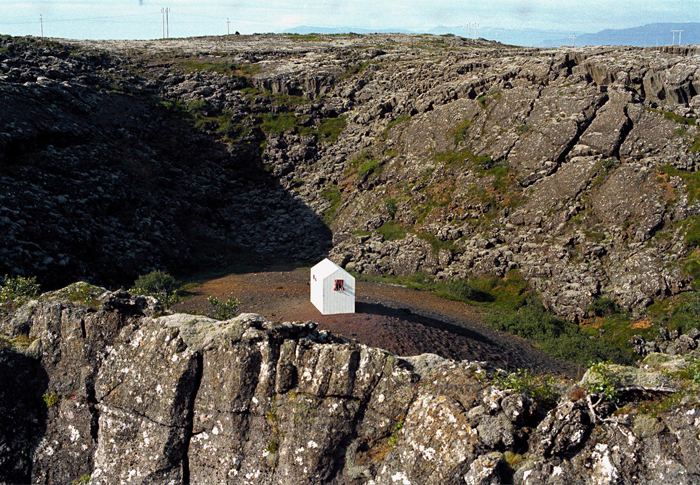

Hreinn Fridfinnsson, House Project (details), 1974. Sixteen color photographs and two texts. Photographs: 7 7⁄8 x 11 7⁄16 in. each; texts: 11 5⁄8 x 8in. each. Moderna Museet, Stockholm.
One of the catalog’s most intriguingly revisionist essays, Emily Eliza Scott’s “Desert Ends,” argues that work like Jean Tinguely’s self-destroying kinetic sculpture and tour-de-force performance titled Study for an End of the World, No. 2. (1962) and Ed Ruscha, Patrick Blackwell, and Mason Williams’s iconic 1967 desert intervention and subsequent artist’s book Royal Road Test13 suggest a possible reconfiguration of our understanding of the desert in relation to the unfolding history of Land art in the Mojave. No longer is the desert the natural preserve celebrated so brilliantly by writers like Edward Abbey in Desert Solitaire.14 Rather, it is a species of technological or military-industrial wasteland, exemplified by the Nevada Test Site, where the U.S. Department of Energy conducted aboveground atomic tests from 1951 to 1962.15 This identification establishes not a “source” for early land projects, but rather an alternative system of signification to which the work of artists like Tinguely, Ruscha, and others can be related discursively in a way that may not have been possible in, say, 1977, when the catalog for Probing the Earth was originally assembled. As Scott trenchantly observes, “The end of a typewriter, like the end of a world… bespeaks the desert’s emerging status in the period as a testing ground—its resonance as an experimental and apocalyptic space.”16
Within this system of discourse, it is also possible to read against the grain, moving from the land projects back into the world of nuclear technology, as is brilliantly demonstrated in the photographic installation Permanent Architecture: Uranium Disposal Cells of America at the Center for Land Use Interpretation here in Los Angeles. The stark black-and-white photographs on view at the CLUI (each one provided with a rich geographical, geological, and historical context) call to mind immediately work like Michael Heizer’s City: Complex One,17 but also remind us that these formal, technological, even ideological resonances take place in a hidden landscape, a secret desert where the marks of human culture rise from or cut into the surface of the land. They confront the entropic forces of Nature against a horizon of geological time or radioactive half-life that ensures their eventual (re)absorption into the landscape, creating an ironic disconnection between the terms “permanent” and “architecture,” or subsuming mechanical excavation into a broader pattern of natural erosion.
If the radioactive waste and relentlessly violated landscape of the Nevada Test Site provide a resonant discursive frame for evaluating many of the great desert land projects at the time of their production, a different image of the desert as a human-implicated wasteland provides a contemporary context within which to evaluate their present state. For unlike many earlier builders (the pharaohs, for example, with their pyramids and tombs articulating a vision of eternity, a “real” eternal architecture), artists like Robert Smithson and Heizer, for example, must always have been aware that their contest with the earth and its entropic forces was an asymmetrical one, in which even the displacement of 240,000 tons of rubble was in the end but a doubly negative and heroically impotent gesture.
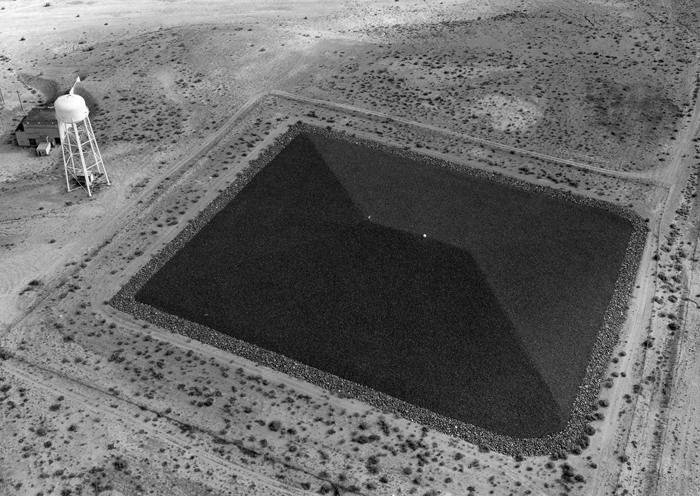
Center for Land Use Interpretation, Green River Disposal Cell, Utah, 2012. Image from the CLUI Archive, with flight support from Lighthawk, 2012.
Indeed, driving from Los Angeles to the site of Heizer’s Double Negative at Mormon Mesa in southwestern Nevada, it is possible to identify at least two such contexts, in addition to that of the bleak, expansive, “empty” desert wasteland that forms the bedrock of all subsequent readings and discourses. The first is provided by the Hoover Dam (built 1931–36) and the landscape and development that surround it. It is a discourse of power, of our ability to impose culture on a recalcitrant natural landscape, to the tune of 4,360,000 cubic yards of concrete (poured in the construction of the dam itself) weighing 6,600,000 tons and backing up the immense artificial reservoir of Lake Mead.18 The landscape is further enmeshed in a tangle of roads, dotted with numerous ancillary structures, crisscrossed by the visible architecture of the dam’s vast power-generating capability, and flooded with tourists. We can easily see it as both the ideological and artifactual opposite of Heizer’s interrupted trench: a very presence rather than a hidden and private absence, an assertion of human power rather than a (tacit) admission of human frailty.
Obviously, the Hoover Dam long predates Heizer’s work on Mormon Mesa, and has formed a kind of backdrop to it throughout its existence. The other immediate context, however, presents quite a different story and is tied to the much more recent explosive expansion of Las Vegas and its environs; yet it is also linked to the dam.
The road up to Mormon Mesa begins in downtown Overton, Nevada, a small agricultural community in the Moapa Valley. Unless one fancies driving through the center of Las Vegas, it is most readily (and scenically) reached by skirting Vegas to the south and then driving north from Henderson through the Lake Mead National Recreation Area (where the discussion between the “natural” and the “manmade” landscape is continuous and subtle).19 Just north of the recreation area lies Overton, near where the Virgin River empties into the northern arm of the lake—indeed, the mesa lies between Overton and the fields that line the river valley.
Until quite recently, the suburban expansion of Las Vegas had rolled smoothly east and south, destined, inevitably it seemed, to swallow up Henderson in a zone of continuous development linking the Strip to the river and the lake. The 2008 collapse of the housing market, however, has left a partially developed zone reaching out toward Henderson from the city: half-built tracts of housing, partially constructed malls, developments cleared or laid out and then left empty, wide empty streets, dust, sage, tumble weeds. It is as though a wave of residential and commercial culture has broken and then receded, leaving its flotsam and jetsam to an uncertain economic future.
Looking across this more-or-less desolate zone is, I’m sure, hardly equivalent to regarding the desolation wrought at the not so distant Nevada Test Site. But it does provide an experience, quite different from that generated by a visit to the dam, against which the desolation of the mesa and the collapse of Heizer’s excavation can be measured and illuminated.
The drive up onto the mesa and out to the Double Negative site is actually quite easy, although the tracks that crisscross the flat plateau have been “improved” only by the passage of 4x4s and pick-up trucks. At first glance, the mesa seems desolate and uninhabited, although it soon becomes clear that it is used, at least occasionally, for running cattle.20 The rockfall across which the original cut (or cuts) was made tumbles down from the edge of the mesa above the winding course of the Virgin River, where it is possible to see both the sinuous green of a riverine habitat and the measured green of land under cultivation.
It is that rockfall—that tear in the fabric of the mesa, that emblem and agent of “natural” entropy—that has expanded in the decades since the original excavation, slowly devouring the double cut that appears so forcefully in aerial photographs as a powerful and primal mark gouged into the surface of the land. On the one hand, it is a brutal expression of alienated human self-awareness, and on the other a beautiful expression of the juxtaposition of cultural and natural orders, where rage against alienation is held in a delicate balance with an acceptance of death and decay as the price we must pay for the articulation of human vision. The actual experience of this tension is at once both ecstatic and humbling, and finally resolves itself as a kind of draining out, a being at ease even if not a being at one, and even if, standing at ease on the edge of the cut, one is also standing, even metaphorically, at Ground Zero.
The experience of Michael Heizer’s Levitated Mass (2012),21 recently installed on a large tract of open land behind the Resnick Pavilion at the Los Angeles County Museum, could hardly be more different. Even leaving aside all the hoopla surrounding the transportation of the 340-ton boulder from its quarry in Riverside County to the site on Wilshire Boulevard, which rather resembled the processional translation of a saint’s relics during the Middle Ages,22 what we are left with is an installation in which an artistic sleight of hand produces not so much a levitation (there is no attempt to conceal the crude but effective mechanism by which the massive weight is held securely in place) as an exercise in role reversal.
If Nature heretofore has functioned as that immutable Other constructed by Culture through a process of reciprocal (self-)definition in which neither term can be completely defined except against the background provided by that natural immutability, here it is Culture rather than Nature that seems to be presented as the necessary ground against which the discourse of reciprocity is played out. In the simplest terms, if Heizer’s Double Negative assumes the priority of Nature (it is the natural landscape into which the cuts that constitute the work are made), Levitated Mass assumes rather the priority of Culture. Even the boulder, so magnificent in its apparently natural presence, is in fact an artificial, quarried thing.
The boulder’s beauty is presented “in the flesh” as the literalization of the aestheticized images captured in the enormous photographs in Heizer’s Actual Size (1970), which was installed at LACMA, along with Actual Size: Munich Rotary (1971), to provide a historicizing context for the “actual” work in Heizer’s earlier photographic practice.23 Actual Size is a stunning “portrait gallery” of megalithic boulders in their natural habitats, and Munich Rotary presents a set of six huge photographic projections “spliced” together so as to give an ostensible sense of being at the bottom of Heizer’s now-destroyed 1969 Munich Depression. Munich Depression itself was quite large—a displacement of 1,000 tons of earth to create a concave form 15 feet deep and 100 feet across. The impression of standing at the bottom of that depression, even if imperfect, that comes from experiencing Munich Rotary was quite impressive. Although a few cranes are visible far in the distance as tiny forms peeking over the “horizon,” I felt rather like I was standing on the bottom of a crater on the moon, even though the marks of human excavation were forcefully present—a very science-fiction effect. Although Levitated Mass has been carefully sited at its LACMA location, the relationship between work and site has been curiously transmuted, and it can hardly be regarded as “site specific” in the same way, for example, as Double Negative or Smithson’s Spiral Jetty. At the same time, however, it also draws attention to the notion of “site” in a quite different (perhaps even an ironic) manner.
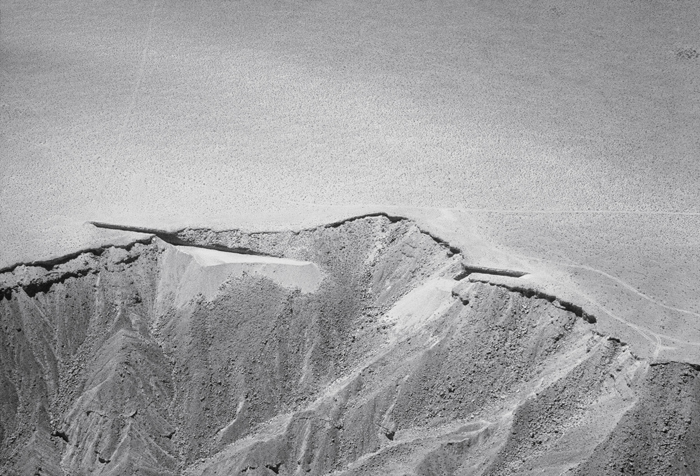
Michael Heizer, Double Negative, 1969–70. 240,000-ton displacement of rhyolite and sandstone, 50 x 30 x 1500 ft. Museum of Contemporary Art, Los Angeles. Gift of Virginia Dwan.
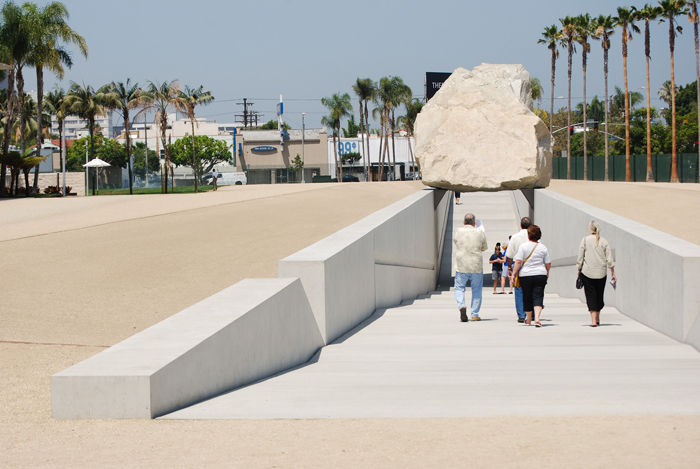
Michael Heizer, Levitated Mass, 2012. Los Angeles County Museum of Art. © Michael Heizer. Photo: Glenn Harcourt, 2012.
Double Negative problematizes the whole idea of “site” and the relationship of work–site–world by the way in which it denies or effaces the dividing lines between these three terms. At first glance, it might seem obvious that the “work” in this case comprises the cuts made in the surface of the mesa according to Heizer’s directions and under his supervision: a double set of negative spaces that mark the presence and the activity of “man” on the land. But surely this is too simple, and the rockfall that splits the cut in two must also comprise an aspect of the work, as something integral both to its form and to its meaning. Yet the rockfall is also a part of the mesa, the ground into which the mark(s) are excavated, the site of the work seen as that place within which the work has been executed. And that “place,” finally, stretches not just out and across the surface of the mesa, but (following the direction of the rockfall) down toward the Virgin River Valley, so that the cuts now exist as part of a potentially and globally expansive space, rather like the furrows turned up by the plowman on the hill in Pieter Bruegel the Elder’s Fall of Icarus (c. 1568).
Indeed, just such a globalizing claim is made for Heizer’s 1969 Munich Depression in the press release announcing the “opening” of the work by Galerie Heiner Fiederich: “This work has no measurements as its limits are infinite.” But this seems patently false in the case of the Munich Depression, where the intention seems rather to create a world below ground, the total extent of which is defined by the “horizon” of the depression’s lip. Hence the stipulation (which essentially guaranteed the work’s eventual destruction) “that enough land surround it so that the shadows of the [ever-encroaching] buildings could never touch it.”24
At the site of Levitated Mass, on the other hand, since “all is culture,” this whole set of relationships can be carefully modulated and arbitrarily controlled. The “work” is almost certainly to be identified with the long and sweeping curve of the concrete ramp, above the nadir of which the great mass of the boulder, bolted securely into place, completes the ensemble: an ostensibly “natural” threat conjured and then neutralized by the artist’s command of engineering skill (or at least through his employment of skilled engineers). The experience of walking down the ramp, slowing as one nears the bottom, standing alone in the shadow of the great menacing rock, is indeed a powerful one: a kind of postmodern or Disneyland sublime— where one feels immersed in a situation marked by mortal danger and yet (unaccountably) protected by an aura of consummate artifice, more like watching The Avengers in 3D than standing on Ground Zero atop Mormon Mesa.25 And, needless to say, the experience of Levitated Mass has been rendered insofar as possible free of all that messy contingency, all that entropic process that complicated both the experience and the actual playing out of the work that is and continues to become Double Negative. The artist has even provided a clear, if somewhat curious, demarcation between the site and the world. Levitated Mass has been set in the midst of a large field of decomposed granite stretching from the back of the Resnick Pavilion north to the edge of the museum’s property at Sixth Street: a flat, uninflected expanse of crushed rock—in a word, “Nature.”

Michael Heizer, Actual Size, installation view at the Los Angeles County Museum of Art, 2012. © 2012 Museum Associates/LACMA.
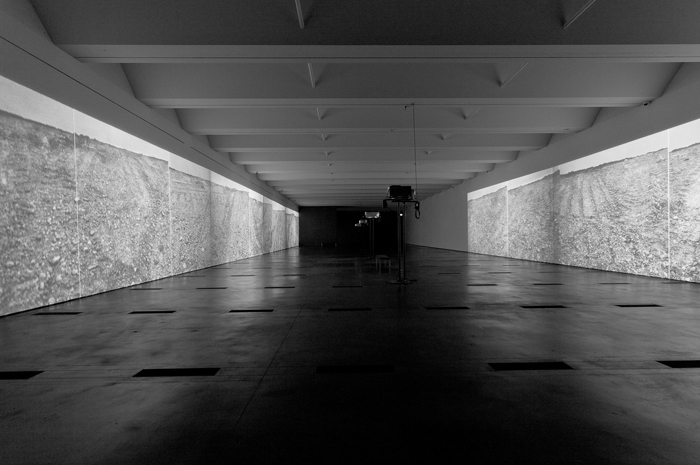
Michael Heizer, Actual Size: Munich Rotary, installation view at the Los Angeles County Museum of Art, 2012. Whitney Museum of American Art, New York. Gift of Virginia Dwan. © Michael Heizer. Photo © 2012 Museum Associates/LACMA.
Within this vast expanse has been set a great oval of core-ten steel, just a few inches wide and flush with the ground, and easy to miss for its rusty color. This oval surrounds the runway dropping down and under the levitated boulder. There is no visible difference between the ground inside and the ground outside the oval; its presence makes no sense except as a means of marking off the space of the work (the “site”) from the space beyond the work (the “world”).
Is this, in fact, a difference without a difference? Or does it perhaps mark off something invisible yet deeply significant, like Kristján Gudmundsson’s Triangle in a Square on view at MOCA’s Ends of the Earth? Does it somehow solve the problem of the work’s existence in the space of the world posed so expansively (yet perhaps unconsciously or implicitly) by Double Negative? Or is it simply a capitulation to the relentlessly depressing yet ever more insistent idea that “Nature” itself has become no more than an apparent simulacrum, the still implacable Other wearing its cultural constructions as a means of concealing from our too limited sight its deadly and entropic potential?
Glenn Harcourt received a PhD in the History of Art from the University of California, Berkeley. He currently lives and works in Los Angeles.
